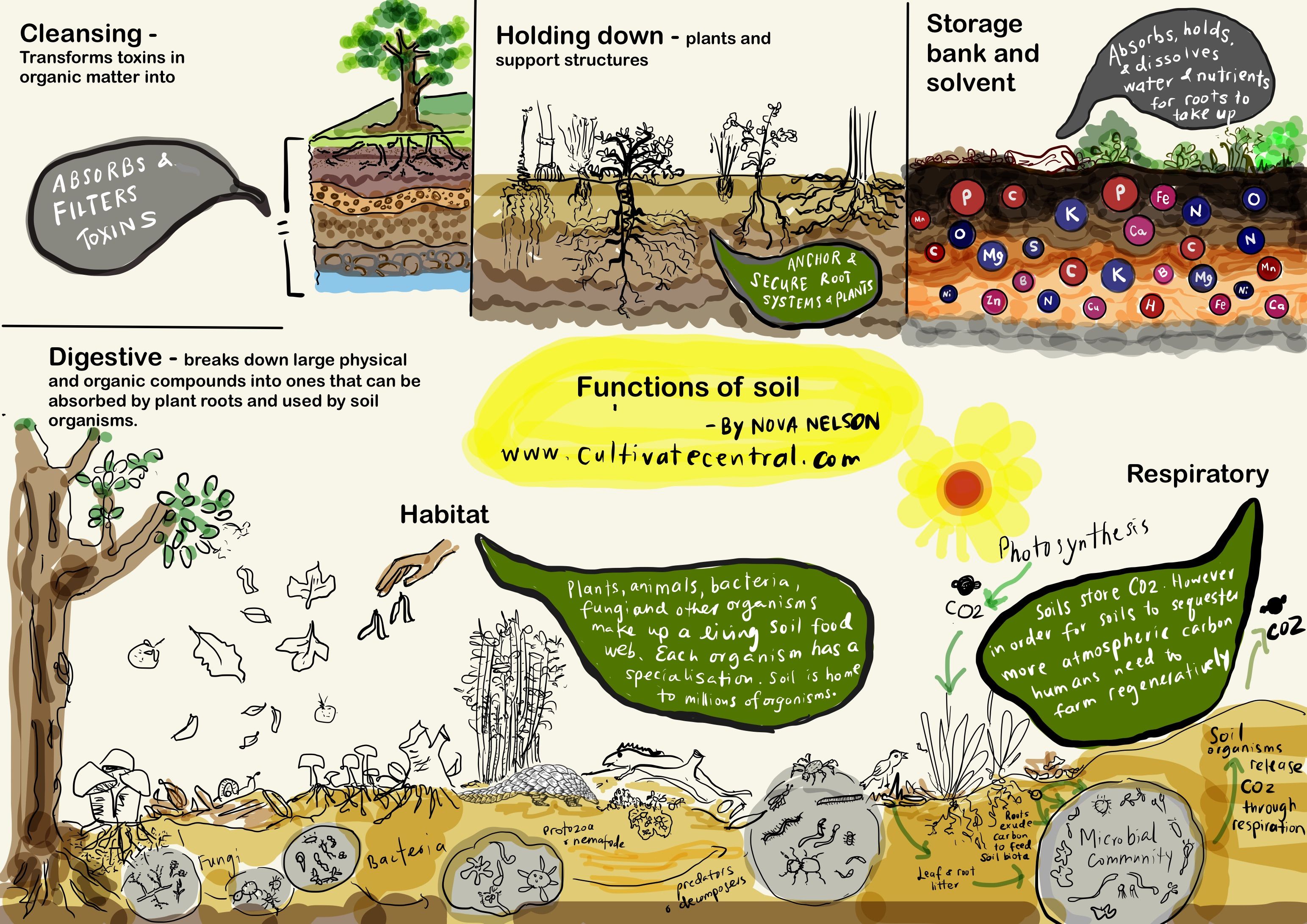
- Mar 23, 2023
- Tamanna Patel
Part 1: Why Soil?
"Heaven is under our feet as well as over our heads.“
- Henry David Thoreau
If you’ve interacted with us you know that the team at Cultivate Central loves soil. But why?
We garden and grow food without chemical fertilisers. We do this on ethical grounds. We know that chemical fertilisers, pesticides, fungicides and herbicides harm waterways, birds, bees, bug life as a whole including soil life and of course human health. How often do we imagine or think about soil life and its role in human and planetary health? Not often at all, this is precisely why we pursue working with soil - even in urban settings.
Nature’s multitasker
The functions of healthy soils in our ecosystems are manifold. Just take a quick peek at our illustration below which explains the functions of healthy soils.
 6 Major Functions of Soil by Nova Nelson
6 Major Functions of Soil by Nova Nelson
It’s good to keep in mind that many of these functions are interdependent and together make soil a powerhouse of nature. Some of these functions are key parts of carbon and water cycles. And this is where soil can play a role in mitigating climate change and its effects, if its role is understood better and regenerative farming practices are used more widely.
Soil and Carbon
As everyone globally is consistently feeling the effects of erratic weather and fluctuating temperatures carbon sequestration has become an oft repeated phrase. But what does it mean? Carbon sequestration is when carbon is captured, removed, and stored in a carbon pool. Soil is one such carbon pool; the other carbon pools are our oceans. At this point in time, in our ecological history there is a great burden on our oceans to sequester carbon.
And so, we need to tap on the ability of soil to counter atmospheric carbon dioxide, So how much carbon can soil really hold? A lot! It has been estimated that all global croplands combined can hold an additional 1.85 gigatons of carbon which is approximately the amount the global transportation sector emits every year (source: Columbia Climate School article). So recarbonising soil is an essential and viable option to counter climate change. And one way society can do this is to move towards adopting regenerative farming and urban greening practices.
Soil and Water
In the process of recarbonising soil, we are also enhancing soil’s ability to store copious amounts of water, helping to protect against the extreme changes in weather. This can help drought affected areas or those going through seasonal dry/heat spells to continue growing food despite weather conditions. Water in the soils also reduces erosion and runoff. Additionally, the more water soil holds the better the chances of it seeping deep down to replenish groundwater and aquifers. Depending on the water-holding capacity of different soils, they can also mitigate floods that arise due to heavy rains. In fact, research has shown that an additional 1% of organic matter added to soil can increase its capacity to absorb water by 20 gallons per acre (source: National Resources Defense Council).
Soil Health
But there’s one caveat, only healthy soils can sequester tonnes of carbon and store it over decades as well as absorb and retain gallons upon gallons of water.
Unfortunately, locally, regionally, and globally soils are struggling to stay healthy. So at Goodman Community Farm (GCF), our demonstrative urban permaculture site in the midst of busy Singapore, we are working to revive soils. And how can you revive soils? What is healthy soil? And can we really make a difference?
Stay tuned for the rest of our mini series on soils inspired by the work on the ground at GCF and we’ll answer all those questions and convince you to love and appreciate soil too!

Tamanna Patel
Tamanna enjoys reading, writing, yoga, being outdoors, and of course gardening. She's on a mission to grow as much of her own food as possible and get composting on a balcony right! It's all a work in progress for her and she dreams of one day owning a piece of land far, far away from the hustle and bustle of cities to cultivate veggies, maybe rear some animals, and watch the stars sparkle in light pollution-free night skies. In the meanwhile, she's happy being content cultivator at Cultivate Central.
Features
Cultivating Change EP#11: Building a Fairer Food Future Together Using Cooperatives
How can a grassroots co-op transform the food on your table—and the lives behind it? . EP#11: Meet Kongsi Co-op — Reimagining Food & Fa...
Cultivating Change #10 Hasan Al Habshi from Pangaea Naturals
In this episode of Cultivating Change, we speak with Hasan Al Habshi, founder of Pangaea Naturals, about beekeeping, producing stingless bee honey, g...
- #PERMACULTURE
- #REGENERATESOIL
- #REGENERATIVEGARDENING
- #SOIL
